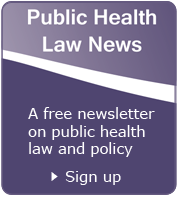Injury & Violence Prevention
Violence and injuries affect everyone, regardless of age, race, or economic status. In the first half of life, more Americans die from violence and injuries—such as motor vehicle crashes, falls, or homicides—than from any other cause, including cancer, HIV, or the flu. Injuries also include those from prescription drug overdose, water-related injuries, brain injuries, sports-related concussions, child maltreatment, intimate partner violence, and suicide.
The Public Health Law Program (PHLP) has released legal analyses of injury-related public health issues.
Violence Prevention
Violence is a serious public health problem in the United States; it affects people in all stages of life. In 2010, more than 16,250 people were victims of homicide and more than 38,360 took their own lives. While many people survive violence, they are left with permanent physical and emotional scars. Violence also erodes communities by reducing productivity, decreasing property values, and disrupting social services.
- Menu of State Batterer Intervention Program Laws [PDF 368KB]
Batterer intervention programs are family violence education programs that provide education, counseling, and behavioral interventions to prevent intimate partner violence. Batterer intervention programs are often mandated in judicial sentencing for domestic violence offenders. This menu is an inventory of state laws that reference batterer intervention programs in statutes or regulations for use by attorneys, public health practitioners, and policy makers.
Prescription Drugs
The United States is experiencing an unprecedented epidemic of prescription drug overdose deaths. The primary responsibility to regulate and enforce prescription drug practices falls to the states. State laws are often used to prevent various injuries, with demonstrated benefits, yet little information exists about the effectiveness of state statutes or regulations designed to prevent prescription drug abuse and diversion. PHLP created menus summarizing some of the legal strategies states have used to address prescription drug misuse, abuse, and overdose. The Public Health Law Program created the menus in partnership with CDC’s National Center for Injury Prevention and Control.
Water-Related Injuries
- CDC Model Aquatic Health Code
Voluntary guidance based on science and best practices that can help local and state authorities make swimming and other water activities healthier and safer.
Graduated Driver Licensing
Motor vehicle crashes are the leading cause of death for teens in the United States. Per mile driven, teen drivers ages 16 to 19 are nearly three times more likely than older drivers to be in a fatal crash. Graduated driver licensing programs (GDL) have consistently proven to be effective at reducing the crash risk for beginning drivers, including teens. GDL addresses the high crash risks that new drivers face by allowing them to get their initial driving experience under low-risk conditions through restrictions enforceable by law.
- Page last reviewed: August 19, 2016
- Page last updated: August 19, 2016
- Content source:




 ShareCompartir
ShareCompartir



